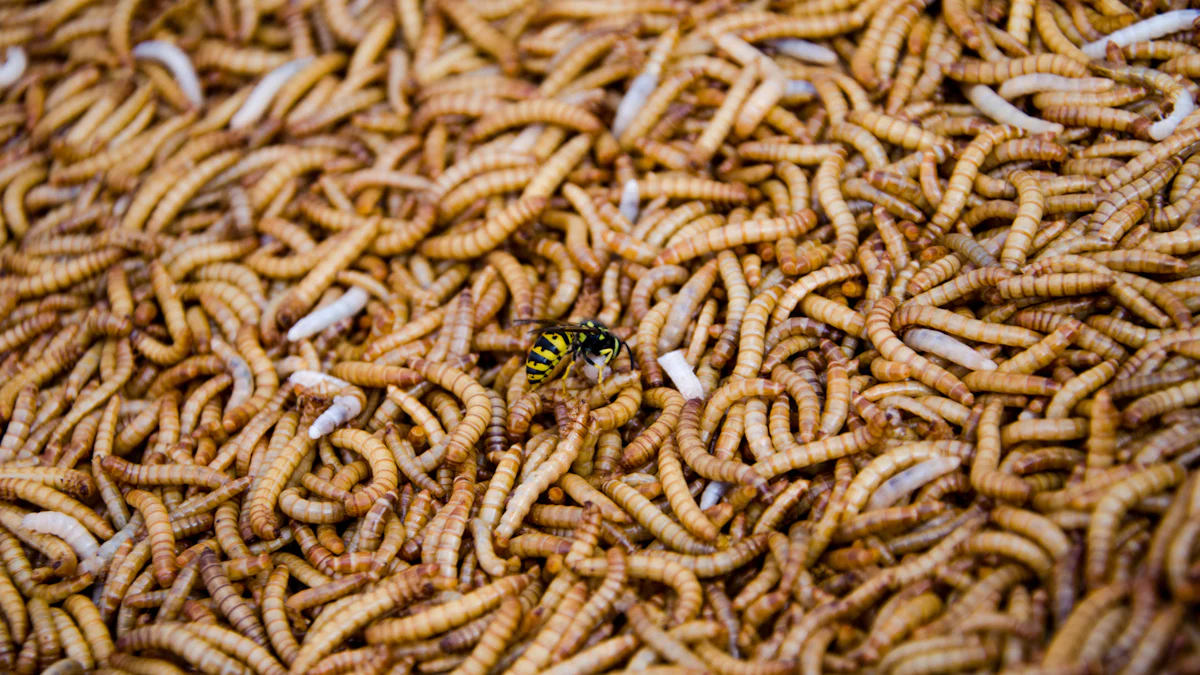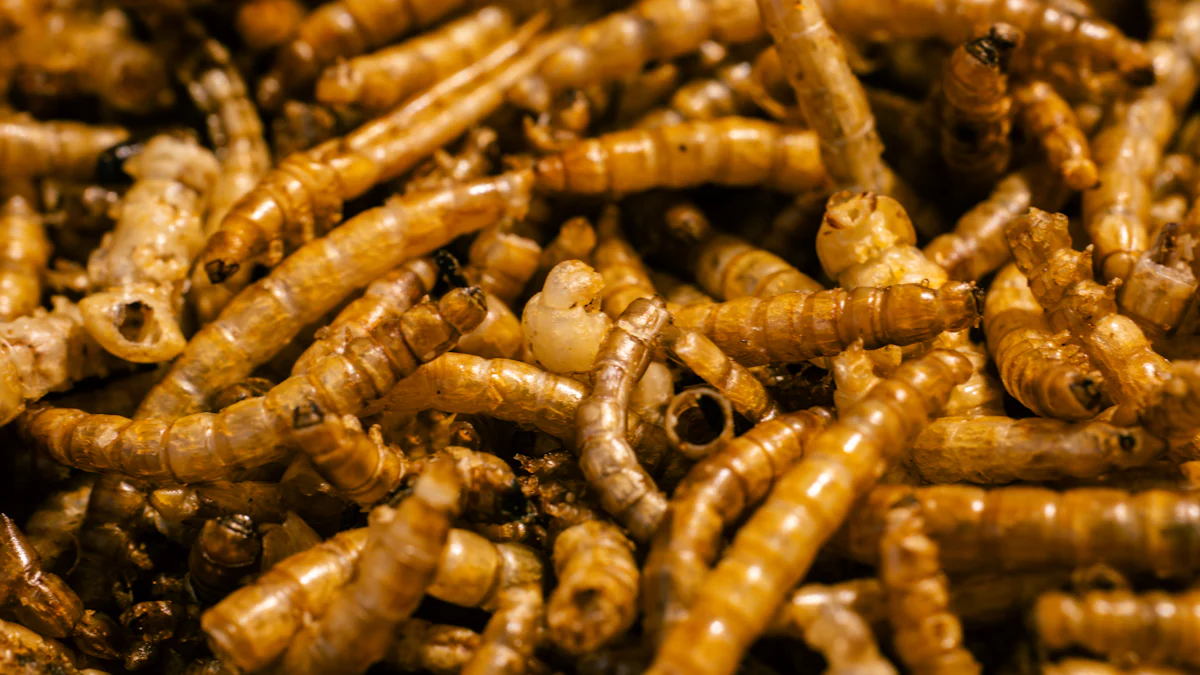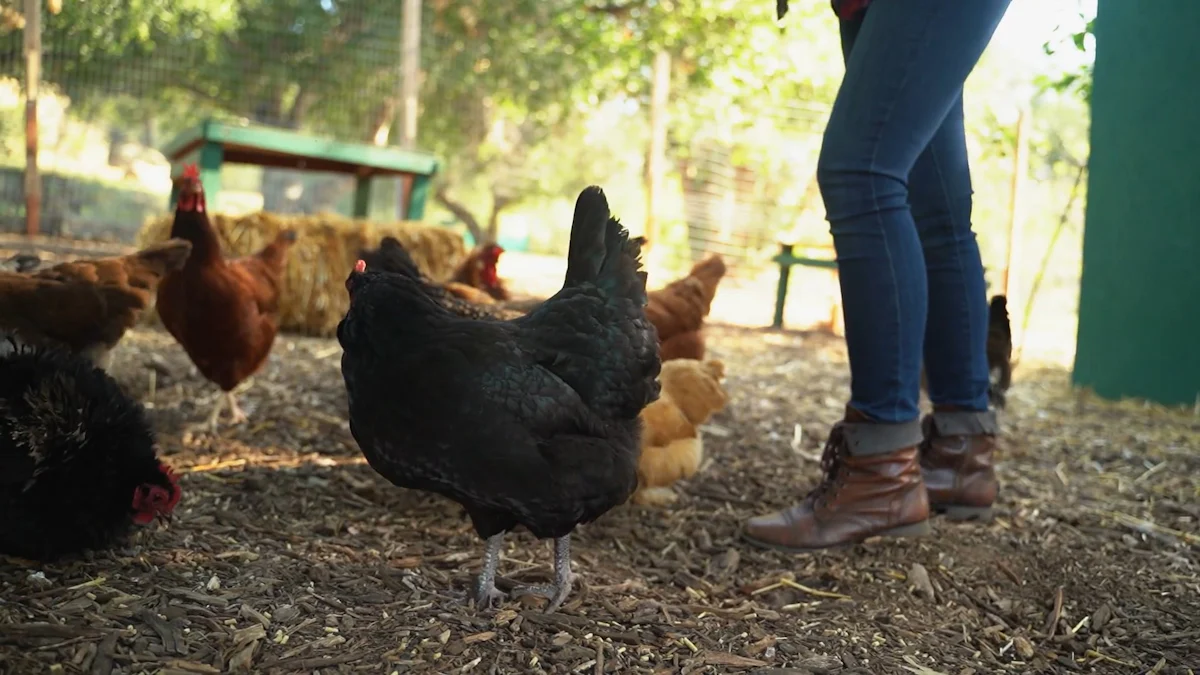
Have you ever wondered what makes mealworms for chickens such a great treat? These little critters pack a punch when it comes to nutrition. They’re about 50% protein, which is way higher than corn or wheat. Plus, they’re loaded with essential amino acids like leucine and lysine. These nutrients help chickens grow strong, develop healthy feathers, and even absorb calcium better. It’s like giving your flock a superfood snack with mealworms for chickens!
Key Takeaways
- Mealworms are packed with protein, about 65%, more than soy or fish. They have important amino acids that help chickens grow and stay healthy.
- It’s important to feed mealworms in small amounts. They should only be 10% of a chicken’s diet to avoid health problems.
- Mealworms are good for the environment. They use less water and space than farm animals, making them a greener option for chicken feed.
Nutritional Benefits of Mealworms for Chickens

Protein Content and Amino Acids
When it comes to protein, mealworms are absolute powerhouses. Did you know mealworm larvae contain about 65% protein? That’s higher than soymeal (43.3%) and even fish meal (62.6%). This makes them a fantastic option for boosting your chickens’ protein intake. Plus, mealworms are packed with essential amino acids like lysine and methionine, which chickens need for growth, feather development, and egg production.
Amino acids aren’t just about building muscle. They also play a role in overall health. For example, glycine and proline, which are often lacking in plant-based feeds, are abundant in animal proteins like mealworms. These amino acids help improve productivity and keep your flock in top shape.
Additional Nutrients and Their Role in Chicken Health
Mealworms aren’t just about protein—they’re a complete package. They’re rich in healthy fats, which give chickens energy and help them absorb vitamins. They also contain fiber for better digestion and essential vitamins like B12, which supports nerve function. Minerals like phosphorus are crucial for strong bones.
What’s even better? Mealworms can improve feather quality, especially during molting, and enhance egg production. You might even notice darker, more vibrant yolks when your chickens enjoy mealworms regularly.
Importance of Moderation in Feeding Mealworms
Here’s the thing: mealworms are treats, not the main course. Overfeeding them can lead to imbalances in your chickens’ diet. Think of it like giving kids too much candy—it’s not great for their health. Stick to small amounts, like a handful for your flock, and make sure mealworms make up no more than 10% of their diet. This way, your chickens get the benefits without missing out on other essential nutrients.
Comparing Mealworms to Other Protein Sources
Mealworms vs. Soy
When it comes to protein, mealworms outshine soy in several ways. For starters, mealworms pack about 51.93 grams of protein per 100 grams, while soy meal offers 44.51 grams. That’s a noticeable difference! Plus, mealworms contain all the essential amino acids chickens need, making them a complete protein source. Soy, on the other hand, often lacks certain amino acids like methionine, which is crucial for feather growth and egg production.
But here’s the catch—soy farming has some serious environmental downsides. It uses a ton of water and contributes to deforestation, especially in places like the Amazon. This not only harms wildlife but also increases carbon emissions. So, while soy is cheaper and more widely available, mealworms for chickens might be the better choice if you’re thinking about sustainability.
Mealworms vs. Fish Meal
Fish meal has long been a popular protein source for chickens, but how does it stack up against mealworms? Both are rich in protein, with fish meal slightly edging out at 62.6%. However, studies show that replacing fish meal with up to 25% mealworms in chicken feed doesn’t affect growth or nutrient absorption. In fact, mealworms can even improve energy efficiency when used in moderation.
That said, fish meal production has its own challenges. Overfishing and habitat destruction make it less sustainable in the long run. While mealworm farming isn’t perfect—it requires more energy and land use—it’s still a promising alternative for reducing the strain on marine ecosystems.
Mealworms vs. Other Insects
Mealworms aren’t the only insects on the menu for chickens. Black Soldier Fly Larvae (BSFL) are another popular option. They’re protein-packed, with levels reaching up to 48%, and they contain more calcium than mealworms. This makes them great for laying hens. BSFL also grow faster and are easier to farm, thriving on organic waste.
However, mealworms have their own perks. They’re higher in fiber, which helps with digestion, and their fat content provides extra energy for chickens. While BSFL might be better for large-scale farming, mealworms remain a versatile and nutrient-rich choice for backyard flocks.
Practical Considerations for Using Mealworms
Cost and Availability
Let’s talk about the cost of mealworms. They’re not the cheapest option out there. Compared to traditional chicken feed like grains or soy, mealworms are pricier. Grains, for example, are widely available and much more budget-friendly, especially if you’re feeding a large flock. But here’s the thing—mealworms might save you money in the long run. Producing them can be less expensive than growing soybeans, though large-scale production still has its challenges.
Availability depends on where you live. The global market for mealworms is growing fast, which is great news. But disruptions, like those caused by COVID-19, have affected supply chains. Plus, rising demand for sustainable proteins has driven up prices. Here’s a quick breakdown:
| Factor Influencing Cost and Availability | Description |
|---|---|
| Global Market Growth | Demand is increasing, which can affect pricing. |
| Impact of COVID-19 | Supply chains faced disruptions. |
| Demand for Alternative Proteins | More interest in sustainability has raised prices. |
| Environmental Concerns | Mealworms’ eco-friendliness boosts their appeal. |
| Health Risks | Concerns about allergies may limit availability. |
Ease of Feeding and Storage
Feeding mealworms is super easy. You can toss them directly to your chickens, and they’ll gobble them up in no time. They’re also easy to store. Freeze-dried mealworms last a long time and don’t need refrigeration. Just keep them in a cool, dry place. If you’re farming your own, you’ll need a bit more effort, but it’s doable with the right setup.
Potential Risks and Feeding Guidelines
Mealworms are safe for chickens, but moderation is key. Overfeeding can lead to overweight birds, which isn’t healthy. I always make sure mealworms are just a treat—no more than 10% of their diet. Chickens also need grit to digest the hard exoskeletons, so don’t forget to provide that. And, of course, always have fresh water available.
Tip: Use mealworms to reward your flock or as a protein boost during molting.
Sustainability of Mealworms for Chickens

Environmental Benefits of Mealworm Farming
When I first learned about mealworm farming, I was amazed at how eco-friendly it is compared to traditional livestock farming. Did you know mealworms need way less water and land to produce the same amount of protein? For example, mealworms have a water footprint of just 4341 m³ per ton, while beef requires a staggering 15,000 m³ per ton. That’s over three times less water!
Mealworms also produce far fewer greenhouse gases. Livestock farming contributes to 80% of agricultural greenhouse gas emissions, but mealworms emit significantly less ammonia, CO2, and methane. Plus, they’re efficient at converting feed into protein. Their feed conversion ratio is comparable to chickens and much better than cattle.
Another cool thing? Mealworms can thrive on food waste, turning scraps into high-quality protein. Their waste, called frass, is a nutrient-rich organic fertilizer. So, not only do mealworms help reduce food waste, but they also support sustainable farming practices.
Comparison with Other Protein Sources in Sustainability
Let’s compare mealworms to other protein sources like soy and fish meal. Here’s a quick breakdown:
| Metric | Mealworm Meal | Soy Meal | Fish Meal |
|---|---|---|---|
| Cumulative Energy Demand | 141.3 MJ | Lower | Lower |
| CO2 Emissions | 3.8 kg CO2 eq | Lower | Lower |
| Acidification Potential | 25.6 g SO2 eq | Lower | Lower |
| Eutrophication Potential | 15.0 g PO4 eq | Lower | Lower |
| Land Use | 4.1 m²/year | Lower | Lower |
Mealworms for chickens clearly stand out as a sustainable option. They use less land and water than soy and fish meal while producing fewer emissions. While their energy demand is slightly higher, their overall environmental impact is much lower.
If you’re looking for a protein source that’s good for your chickens and the planet, mealworms are a fantastic choice. They’re a step toward more sustainable and ethical farming practices.
Mealworms for chickens are a game-changer. They’re packed with protein, healthy fats, and essential nutrients like B12 and phosphorus. These benefits make them a fantastic supplement for growth, feather health, and egg production. Plus, they promote natural foraging behavior and support sustainable feeding practices.
That said, moderation is key. I always remind myself to keep mealworms as a treat—no more than 10% of my flock’s diet. It’s also important to provide grit for digestion and balance their meals with other feeds.
Before diving in, think about your flock’s needs. Are they molting or laying eggs? Do you want to prioritize sustainability? Mealworms might cost more than grains, but their eco-friendliness and nutritional value can make them worth it.
If you’re ready to give your chickens a boost, mealworms are a great place to start. They’re not just a treat—they’re an investment in your flock’s health and the planet’s future.
FAQ
Can I feed my chickens live mealworms?
Yes, you can! Chickens love live mealworms. They’ll chase them around, which encourages natural foraging behavior. Just don’t overdo it—treats should stay under 10% of their diet. 🐛
Are mealworms safe for baby chicks?
Absolutely, but crush them first to make them easier to eat. Baby chicks need protein for growth, and mealworms are a great supplement in small amounts.
Tip: Start with tiny portions and watch how your chicks respond.
How do I store mealworms?
Freeze-dried mealworms are the easiest to store. Keep them in a cool, dry place. If you’re raising live ones, maintain a clean, ventilated container with proper food and bedding.
Note: Always check for mold or spoilage before feeding mealworms to your flock.


